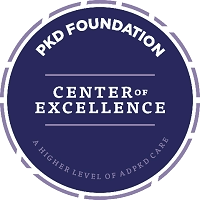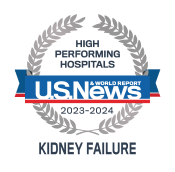Polycystic Kidney Disease
Dr. Terry J. Watnick, MD, and Dr. Stephen L. Seliger, MD, discuss UMMC's approach to PKD treatment and research.
Polycystic kidney disease (PKD) is the most common inherited kidney disorder in the world that can lead to end stage kidney disease.
While there is currently no cure, there is a lot of ongoing research in this area, both nationwide and at the University of Maryland Medical Center.
Get Help for PKD
The PKD Foundation has designated the University of Maryland Medical Center as a Center of Excellence for PKD clinical care. This honor means people with PKD get the highest level of comprehensive, patient-centered care from our nephrologists and their network of specialists.
As part of a large academic and medical campus, our nephrologists work with researchers and other providers to develop new therapies for kidney disease. PKD patients can see excellent outcomes with our "bench-to-bedside" approach, which has the potential to turn the latest research into practical treatment.
When people with PKD need a kidney transplant, we offer unique treatment because we can remove both failed kidneys and transplant a new one in the same operation, usually from a living donor. This means people don't have to undergo two anesthetics and recover from two separate surgeries. Many centers don't have the experience and resources to support such a complex surgery.
Contact us today at 410-706-3455 to make an appointment with one of our nephrologists. If you're interested in our research studies, check our current clinical trials to see what we're participating in.
Visit Us
We have two locations in Baltimore:
University of Maryland Medical Center Professional Building
419 West Redwood Street
Baltimore, MD 21201
Get directions and parking information
University of Maryland Midtown Health Center
800 Linden Ave
Baltimore, MD 21201
Get directions and parking information
What Is PKD?
When a patient has PKD, their kidneys are slowly replaced by cysts, or bubbles of fluid. After many years, the sacks of fluid displace the normal kidney tissue, causing the kidneys to stop working.
PKD Symptoms
In early PKD, there are usually no symptoms. People who develop symptoms will generally do so between the ages of 30 and 40. Common symptoms include high blood pressure, urinary tract infections, bloody urine, headaches and lower back pain.
Some patients get very large abdomens because their kidneys have grown to the size of footballs or bigger. This leads to problems with feeling full quickly because there is not enough room in the stomach, or shortness of breath because the kidneys take up so much room in the abdomen. Sometimes patients can have bleeding from their kidneys because the cysts rupture, which is also painful.
Many patients with PKD also have polycystic liver disease (PLD). Some patients have a small number of liver cysts and their liver may stay at a normal size. In other patients, the liver becomes filled with cysts and gets extremely enlarged.
No matter the number or size of cysts, polycystic livers typically continue to function normally. Symptoms are related to the liver size. If the liver becomes enlarged with cysts, symptoms may include abdominal pain, bloating or swelling in the abdomen, difficulty eating or difficulty taking a deep breath.
Progression of PKD looks different for everyone, even people in the same family, so it's important to understand if you are at risk of your PKD progressing at a faster rate. Our PKD specialists can help you determine your risk of progression.
Diagnosing PKD
Since PKD is a genetic disease, doctors use a family history of PKD as well as imaging techniques (ultrasound, CT, MRI) to detect cysts in the kidney and other organs to help make a diagnosis.
A positive family history is known in about 75 percent of patients with PKD, but there may be no family history of the disease.
Genetic testing is also available. It can be done when there's no family history or if imaging results are not typical of PKD. The option of genetic testing can be considered on a case-by-case basis and after discussion with your nephrologist.
PKD Treatment
In April 2018, the FDA approved a new drug called Jynarque to treat autosomal dominant polycystic kidney disease (ADPKD). In clinical trials, Jynarque was demonstrated to slow kidney function decline and slow the rate of kidney growth in adults at risk for ADPKD.
Jynarque has side effects that will be managed by your nephrologist. The most common are increased thirst, making large amounts of urine, urinating often and urinating at night.
Jynarque is currently the only PKD treatment on the market. Identifying additional PKD treatments is an active area of research. Until other methods to treat or cure the disease are discovered, patients can manage their symptoms (high blood pressure, urinary tract infections, bloody urine, headaches and pain) and prevent complications to maximize their health and length of time with their native kidneys.
Getting a Kidney Transplant
Not everyone with PKD will need a kidney transplant. Some forms of PKD are less severe. Some people with PKD make it to their 70s or later with their own kidneys.
Typically, we start evaluating for transplantation when the creatinine clearance gets below 20. Normal creatinine clearance is between 80-120.
Visit our Kidney Transplant Center to learn more.
Learn More About PKD


